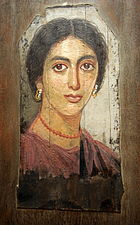Encaustic painting, also known as hot wax painting, involves using heated beeswax to which colored pigments are added. The liquid or paste is then applied to a surface—usually prepared wood, though canvas and other materials are often used. The simplest encaustic mixture can be made from adding pigments to beeswax, but there are several other recipes that can be used—some containing other types of waxes, damar resin, linseed oil, or other ingredients. Pure, powdered pigments can be used, though some mixtures use oil paints or other forms of pigment.
Metal tools and special brushes can be used to shape the paint before it cools, or heated metal tools can be used to manipulate the wax once it has cooled onto the surface. Today, tools such as heat lamps, heat guns, and other methods of applying heat allow artists to extend the amount of time they have to work with the material. Because wax is used as the pigment binder, encaustics can be sculpted as well as painted. Other materials can be encased or collaged into the surface, or layered, using the encaustic medium to stick them to the surface.
Contents
History

Fayum mummy portrait
The word encaustic originates from the Greek word enkaustikos[1] which means to burn in, and this element of heat is necessary for a painting to be called encaustic.
This technique was notably used in the Fayum mummy portraits from Egypt around 100–300 AD, in the Blachernitissa and other early icons, as well as in many works of 20th-century North American artists, including Jasper Johns, Tony Scherman, Mark Perlman, and Fernando Leal Audirac. Kut-kut, a lost art of the Philippines, implements sgraffito and encaustic techniques. It was practiced by the indigenous tribe of Samar island around 1600 to 1800.[2] Artists in the Mexican muralism movement, such as Diego Rivera[3] and Jean Charlot[4] sometimes used encaustic painting. The Belgian artist James Ensor also experimented with encaustic.[5]

The Mummy of Demetrios, 95-100 C.E.,11.600a-b, Brooklyn Museum
The wax encaustic painting technique was described by the Roman scholar Pliny the Elder[6] in his Natural History from the 1st Century AD. The oldest surviving encaustic panel paintings are the Romano-Egyptian Fayum mummy portraits[7] from the 1st Century BC.
In the 20th century, painter Fritz Faiss (1905–1981), a student of Paul Klee and Wassily Kandinsky at the Bauhaus, together with Dr. Hans Schmid, rediscovered the so-called "Punic wax" technique of encaustic painting. Faiss held two German patents related to the preparation of waxes for encaustic painting. One covered a method for treating beeswax so that its melting point was raised from 60 degrees Celsius to 100 degrees Celsius (from 140 °F to 212 °F). This occurred after boiling the wax in a solution of sea water and soda three successive times. The resulting harder wax is the same as the Punic wax referred to in ancient Greek writings on encaustic painting.
Encaustic art has seen a resurgence in popularity since the 1990s with people using electric irons, hotplates and heated stylus on different surfaces including card, paper and even pottery. The iron makes producing a variety of artistic patterns easier. The medium is not limited to just simple designs; it can be used to create complex paintings, just as in other media such as oil and acrylic.
Encaustic painters
Artists specializing in encaustic painting include the following.


